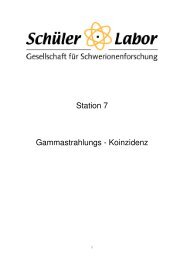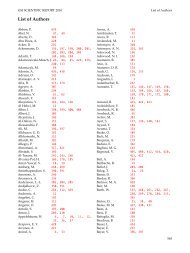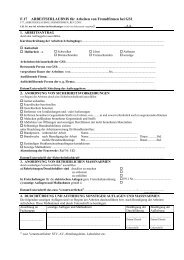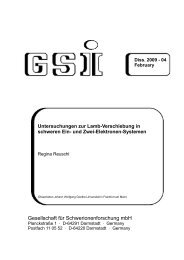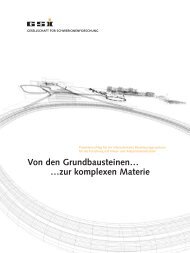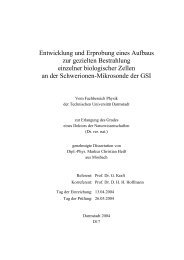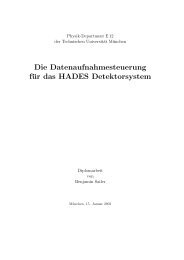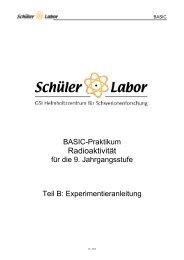CBM Progress Report 2006 - GSI
CBM Progress Report 2006 - GSI
CBM Progress Report 2006 - GSI
You also want an ePaper? Increase the reach of your titles
YUMPU automatically turns print PDFs into web optimized ePapers that Google loves.
<strong>CBM</strong> <strong>Progress</strong> <strong>Report</strong> <strong>2006</strong> Simulations<br />
Global tracking and hadron identification in the <strong>CBM</strong> experiment<br />
The physics programme of the <strong>CBM</strong> experiment at FAIR<br />
includes a systematic investigation of hadron production in<br />
heavy-ion reactions as function of collision energy and system<br />
size. Of particular interest are event-by-event fluctuations<br />
in the particle ratios as well as directed and elliptic<br />
flow. For this purposes, excellent identification of pions,<br />
kaons and protons is indispensable. It will also help to reduce<br />
the background for the measurements of open charm<br />
and hyperons detected by their weak-decay topology.<br />
Hadron identification in <strong>CBM</strong> will be performed by a<br />
time-of-flight (TOF) wall situated about 10 m downstream<br />
of the interaction target. It will consist of RPC chambers<br />
with pad and/or strip readout. A system time resolution of<br />
80 ps at a maximal rate of 20 kHz/cm 2 is aimed at.<br />
The feasibility of the particle identification via TOF<br />
measurement relies on the matching of a hit in the TOF detector<br />
to the momentum measurement in the Silicon Tracking<br />
System (STS) of <strong>CBM</strong>, which is located directly after<br />
the target. Several layers of Transition Radiation Detectors<br />
(TRD) fill the space between STS and TOF and allow<br />
extrapolating a track found in the STS towards the TOF<br />
wall. Hadron identification in <strong>CBM</strong> thus requires track reconstruction<br />
in the STS, tracking through the TR detectors<br />
(either by track-following from the STS or by standalone<br />
TRD tracking plus merging with STS tracks), and matching<br />
of a TOF hit to the reconstructed global track.<br />
In this study, we use a Cellular Automaton method for<br />
tracking in the STS (see I. Kisel et al., this report). The reconstruction<br />
efficiency for primary tracks in central Au+Au<br />
collision at 25 AGeV is about 96 %. A 3-D track following<br />
method based on a Kalman filter is employed to prolong<br />
the tracks throughout the TRD system. A TRD track<br />
reconstruction efficiency of about 94 % is obtained. The<br />
global track is then extrapolated towards the TOF wall, and<br />
the nearest TOF hit is attributed to it. Fig. 1 shows the<br />
efficiency of TOF hit matching (left) and the total TOF efficiency<br />
(right), including STS and TRD reconstruction efficiencies,<br />
as a function of momentum. These results were<br />
obtained with a realistic description of the RPC coordinate<br />
resolution, taking into account the single gap response also<br />
in case of mutiple hits and inclined tracks.<br />
The losses in TOF-track matching of about 7 % are dominated<br />
by particle decays and double hits in the RPCs. The<br />
latter contribution amounts to some 2 % and can be reduced<br />
by resolving double hits in the RPC strip readout.<br />
Optimisation of the RPC pad/strip sizes is ongoing in order<br />
to reduce the number of electronic channels while roughly<br />
keeping the performances.<br />
The global event reconstruction is completed by attach-<br />
D. Kresan and V. Friese<br />
<strong>GSI</strong>, Darmstadt, Germany<br />
7<br />
Figure 1: Efficiency of (left) matching a TOF hit with a<br />
global track and (right) total TOF reconstruction efficiency<br />
as function of momentum<br />
ing reconstructed rings in the RICH to the global track,<br />
which enables electron identification. With these new reconstruction<br />
algorithms, developed in the course of the last<br />
year in the framework of <strong>CBM</strong>ROOT, a complete reconstruction<br />
of simulated events is now available, giving path<br />
to feasibility studies of physics observables.<br />
Figure 2: (Left) reconstructed particle mass from the TOF<br />
measurement as function of momentum; (right) mass spectrum<br />
derived from TOF at p = 3 GeV<br />
As an example, fig. 2 (left) shows the reconstructed<br />
squared particle mass from the time-of-flight, track length<br />
and momentum, as a function of momentum, for an assumed<br />
time resolution of 80 ps. The reconstructed mass<br />
spectrum at p = 3 GeV is shown on the right side of the<br />
figure. With an overall efficiency of 80 % to 90 %, separation<br />
of kaons and pions can be achieved up to laboratory<br />
momenta of about 3.5 GeV, while protons can be identified<br />
up to 7 GeV.



